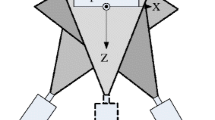Abstract
Stereo digital image correlation (DIC) is now a standard measurement technique. It is, therefore, important to quantify the measurement uncertainties when using it for experiments. Because of the complexity of the DIC measurement process, a Monte Carlo approach is presented as a method to discover the magnitude of the stereo-DIC calibration uncertainty. Then, the calibration errors, along with an assumed sensor position error, are propagated through the stereo-triangulation process to find the uncertainty in three-dimensional position and object motion. Details on the statistical results of the calibration parameters are presented, with estimated errors for different calibration targets and calibration image quality. A sensitivity study was done to look at the influence of the different calibration error sources. Details on the best approach for propagating the errors from a statistical perspective are discussed, including the importance of using a “boot-strap” approach for error propagation because of the covariance of many of the calibration parameters. The calibration and error propagation results are then interpreted to provide some best-practices guidelines for DIC.















Similar content being viewed by others
References
Reu PL, Miller TJ (2008) The application of high-speed digital image correlation. J Strain Anal Eng Des 43(8):673–688
Bornert M et al (2009) Assessment of digital image correlation measurement errors: methodology and results. Exp Mech 49(3):353–370
Lava P et al. Assessment of measuring errors in DIC using deformation fields generated by plastic FEA. Opt Lasers Eng 47(7–8):747–753
Fazzini M et al (2010) Study of image characteristics on digital image correlation error assessment. Opt Lasers Eng 48(3):335–339
Pan B et al (2006) Performance of sub-pixel registration algorithms in digital image correlation. Meas Sci Technol 17(6):1615–1621
Tong W (2005) An evaluation of digital image correlation criteria for strain mapping applications. Strain 41(4):167–175
Siebert T et al. (2007) High-speed digital image correlation: error estimations and applications. Opt Eng 46(5)
Haddadi H, Belhabib S (2008) Use of rigid-body motion for the investigation and estimation of the measurement errors related to digital image correlation technique. Opt Lasers Eng 46(2):185–196
Nansteel MW, Chen CCT (2009) Digital image correlation: a measurement tool for the study of explosive effects. 2009 Ieee Conference on Technologies for Homeland Security pp 226–233
Schreier HW, Sutton MA (2002) Systematic errors in digital image correlation due to undermatched subset shape functions. Exp Mech 42(3):303–310
Wang ZY et al (2007) Statistical analysis of the effect of intensity pattern noise on the displacement measurement precision of digital image correlation using self-correlated images. Exp Mech 47(5):701–707
Wang YQ et al (2011) On error assessment in stereo-based deformation measurements. Exp Mech 51(4):405–422
Ke XD et al (2011) Error assessment in stereo-based deformation measurements. Exp Mech 51(4):423–441
BIPM (2009) Evaluation of measurement data—supplement 1 to the “Guide to the expression of uncertainty in measurement”—propagation of distributions using a Monte Carlo method. JCGM 101:2008
Di Leo G, Liguori C, Paolillo A (2011) Covariance propagation for the uncertainty estimation in stereo vision. IEEE Trans Instrum Meas 60(5):1664–1673
Hu Z et al (2011) Error evaluation technique for three-dimensional digital image correlation. Appl Opt 50(33):6239–6247
BIPM (2008) Evaluation of measurement data—guide to the expression of uncertainty in measurement. JCGM 100:2008
Sutton DA, Orteu JJ, Schreier HW (2009) Image correlation for shape, motion and deformation measurements. Springer, New York
Hartley RI, Sturm P (1997) Triangulation. Comp Vision Image Underst 68(2):146–157
Efron B, Tibshirani R (1993) An introduction to the bootstrap. CRC Press, United States of America, p 463
Horn BKP (1987) Closed-form solution of absolute orientation using unit quaternions. J Opt Soc Am A 4(4):629–642
Acknowledgments
The help of Stephanie Fitchett for her many discussions regarding statistics and the Monte Carlo method are greatly appreciated. For help understanding DIC and photogrammetry I would like to thank Tim Miller and Hubert Schreier.
Sandia National Laboratories is a multi-program laboratory managed and operated by Sandia Corporation, a wholly owned subsidiary of Lockheed Martin Corporation, for the U.S. Department of Energy’s National Nuclear Security Administration under contract DE-AC04-94AL85000.
Author information
Authors and Affiliations
Corresponding author
Rights and permissions
About this article
Cite this article
Reu, P. A Study of the Influence of Calibration Uncertainty on the Global Uncertainty for Digital Image Correlation Using a Monte Carlo Approach. Exp Mech 53, 1661–1680 (2013). https://doi.org/10.1007/s11340-013-9746-1
Received:
Accepted:
Published:
Issue Date:
DOI: https://doi.org/10.1007/s11340-013-9746-1




